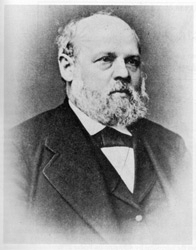Geissler, Johann Heinrich Wilhelm
Johann Heinrich Wilhelm Geissler (1814-1879), the German physicist and glassblower for whom the Geissler (mercury) pump (1855) and the Geissler tube (1857) are named. The mercury vacuum pump contributed to the success of Thomas Edison's first incandescent lamps in 1879. The sealed glass tubes that bear his name are still in use today because they illustrate the luminous effects of discharges through rarefied gases.
Geissler's tubes incorporated combinations of attractive shapes such as bells, bubbles, curlicues, twists, and bends, and they emitted brilliant and colorful fluorescent light when passed though by high voltage. These vacuum discharge tubes played an important role in the experimental course of physics. His other contributions include a vaporimeter, mercury air pump, balances, normal thermometer, and areometer.
Further Reading
Geissler - Biography (Hebrew University of Jerusalem, Institute of Chemistry)
Geissler Tubes (Kenyon College, Physics Department)

